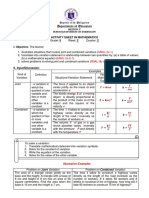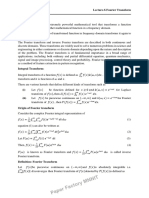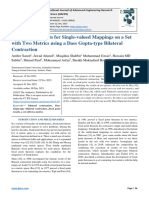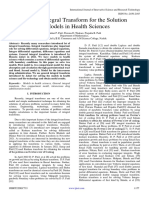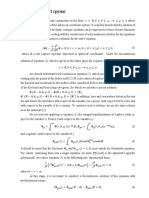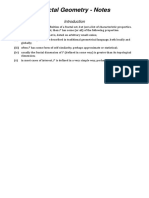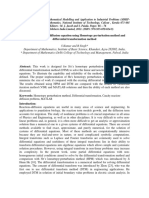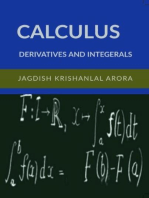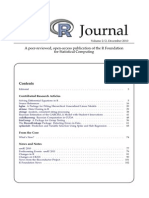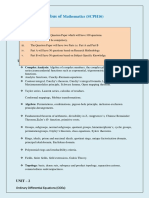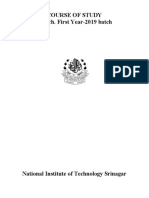Professional Documents
Culture Documents
Kharrat-Toma Transform and Its Application in Solving Some Ordinary Differential Equations With Initial Boundary Conditions
Copyright
Available Formats
Share this document
Did you find this document useful?
Is this content inappropriate?
Report this DocumentCopyright:
Available Formats
Kharrat-Toma Transform and Its Application in Solving Some Ordinary Differential Equations With Initial Boundary Conditions
Copyright:
Available Formats
Volume 6, Issue 8, August – 2021 International Journal of Innovative Science and Research Technology
ISSN No:-2456-2165
Kharrat-Toma Transform and its Application in
Solving Some Ordinary Differential Equations with
Initial Boundary Conditions
MUSTAPHA R. A.1 , SALAU A. M.2 , BABATUNDE Idowu.3 OGABI C. O.4 , IDOWU G. A.5
1,2,5
Department of Mathematics, Lagos State University, Ojo, Lagos, Nigeria
3,4
Department of Physics, Lagos State University, Ojo, Lagos, Nigeria
Abstract:- In this paper, we adopted a new integral transform in [8], Laguerre transform by Edmond Laguerre in
transform called Kharrat-Toma Transform which can [9], G.K. watugula introduced the Sumudu transform in
be considered to be a basis for a number of potential new [10]. Natural Transform was initiated by Khan and Khan in
integral transforms. Some fundamental properties about [11]. The Aboodh transform was presented by Khalid .S.
this new integral transform were used in this work, Aboodh in [12]. The Elzaki transform was presented by
includes the existence theorem, transportation theorem, Tarig M. Elzaki in [13]. The new integral transform “M-
convolution theorem and inversion equation. The major transform” was suggested by Srivastava in [14]. The ZZ
advantage of this new technique is that it solves ordinary transform was devised by Zafar in [15], A. Kamal and H.
differential equation with variable and constant Sedeeq proposed the Kamal Transform in [16], the Yang
coefficients. Some relevant examples were solved to show transform was introduced by Xiao-jun Yang in [17]. And
the efficiency of this technique. finally R. Saaduh et al introduced ARA transform in [18].
Keywords:- Kharrat-Toma Transform, Ordinary Differential Kharrat et al also interested in integral transform
Equations, Exact Solution. methods, where they applied the Differential transform to
solve boundary value problems represented by differential
I. INTRODUCTION equations from higher orders and also to solve a system of
differential equation [19-21]. In addition, they suggested
Differential equations plays vital role in engineering, hybridization the homotopy perturbation method with
physics, mathematics, Applied mathematics, chemistry and sumundu transform to solve initial value problems for
physiology Applications; In the research work, we suggest nonlinear partial differential equation [22], They also
to develop a new technique for obtaining solution which introduced the hybridization of the Natural transform
approximate the exact solution. method with the homotopy perturbation method to solve
Van Der pol oscillator problem [23].
There are many integral transforms widely used to
solve the differential equation and thus there are several The purpose of this work is to show the efficiency and
works on the differential transform such as laplace applicability of the new integral transform and applied it to
transform was introduced by P.S. Laplace in 1780’s [1], solve Ordinary differential equations with variable and
laplace transform is the oldest integral transform and the constant coefficients as proposed by Kharrat et al in [24].
most widely used. The Stieltjes in [2], was the first to give a The rest of the paper is as follows: we present the basic idea
systematic formulation of the mellin transformation in [3], of Kharrat-Toma transform in Section 2. In Section 3,
The Mohomd Transform was introduced by mohomd Kharrat-Toma transform of some functions is introduced
M.Mahgoub in [4], S. Ahmad et al proposed a new integral and we proof some properties, In section 4, the application
transform to solve higher order linear Laguerre and Hermite for solving ordinary differential equation is shown and
differential equations in [5], D. Hilbert Suggested the conclusion in section 5.
Hilbert transform in [7], J. Radon founded the radon
Kharrat-Toma Transform: Definition 1. The function 𝑓(𝑥) is said to have exponential order on every finite interval in [0, +∞)
If there exist a positive number M that satisfying: |𝑓(𝑥)| ≤ 𝑀𝑒 ∝𝑥 , 𝑀 > 0, ∝> 0, ⩝ 𝑥 ≥ 0
Definition 2: The Kharrat-Toma integral transform and inversion is defined by.
∞
−𝒙
𝟑∫
𝑩[𝒇(𝒙)] = 𝑮(𝒔) = 𝒔 𝒇(𝒙) 𝒆 𝒔𝟐 𝒅𝒙 , 𝒙 ≥ 𝟎
𝟎
∞
−𝒙
𝒇(𝒙) = 𝑩−𝟏 [𝑮(𝑺)] = 𝑩−𝟏 [𝒔𝟑 ∫ 𝒇(𝒙) 𝒆 𝒔𝟐 𝒅𝒙]
𝟎
IJISRT21AUG187 www.ijisrt.com 224
Volume 6, Issue 8, August – 2021 International Journal of Innovative Science and Research Technology
ISSN No:-2456-2165
The B integral transform states that, if 𝑓(𝑥) is piecewise continuous on [0, +∞) and has exponential order. The 𝑩−𝟏 will be
the inverse of the 𝐵 integral transform.
Theorem 1: [Sufficient Condition for Existence of a Kharrat-Toma Transform]: The Kharrat-Toma transform 𝑩[𝒇(𝒙)] exists
𝒃
if it has exponential order and ∫𝟎 |𝒇(𝒙) | 𝒅𝒙 exists for any 𝑏 > 0.
Proof:
∞ 𝒏 ∞
−𝒙 −𝒙 −𝒙
𝟑∫ |𝒇(𝒙) 𝒆 𝒔𝟐 | 𝒅𝒙 𝟑 ∫ |𝒇(𝒙) 𝒆 𝒔𝟐 | 𝒅𝒙 𝟑∫ |𝒇(𝒙) 𝒆 𝒔𝟐 | 𝒅𝒙
𝒔 =𝒔 +𝒔
𝟎 𝟎 𝒏
𝒏 ∞
−𝒙
𝟑 ∫|𝒇(𝒙) | 𝒅𝒙 + 𝒔𝟑 ∫|𝒇(𝒙) | 𝒆 𝒔𝟐 𝒅𝒙
≤𝒔
𝟎 𝟎
𝒏 ∞
−𝒙
𝟑 ∫|𝒇(𝒙) 𝟑∫
≤𝒔 | 𝒅𝒙 + 𝑴𝒔 𝒆∝𝒙 𝒆 𝒔𝟐 𝒅𝒙
𝟎 𝟎
𝒏 ∞
𝟏
𝟑 ∫|𝒇(𝒙) | 𝟑∫ −( 𝟐 −∝)𝒙
=𝒔 𝒅𝒙 + 𝑴𝒔 𝒆 𝒔 𝒅𝒙
𝟎 𝟎
𝒏
𝑩
𝟑 ∫|𝒇(𝒙) |
𝑴𝒔𝟑 𝟏
−( −∝)𝒙 𝟏
=𝒔 𝒅𝒙 + 𝐥𝐢𝐦 [𝒆 𝒔𝟐 ] ; 𝟐 >∝
𝟏 𝑩→∞ 𝒔
𝟎 − ( 𝟐 −∝) 𝟎
𝒔
𝒏
𝟑 ∫|𝒇(𝒙)
𝑴𝒔𝟑
=𝒔 | 𝒅𝒙 +
𝟏
𝟎 −∝
𝒔𝟐
−𝒙
𝟏 ∞
The first integral exists, and the second term is finite for >∝ , so the integral 𝒔𝟑 ∫𝟎 𝒇(𝒙) 𝒆 𝒔𝟐 𝒅𝒙 converges absolutely and the
𝒔𝟐
Kharrat-Toma 𝑩[𝒇(𝒙)] exists.
Kharrat-Toma Transform of Some Functions: In this section we find Kharrat-Toma transform of some functions;
𝑩
𝒇(𝒙) = 𝟏 ←→ 𝑮(𝒔) = 𝒔𝟓 (1)
𝑩−𝟏
𝑩
𝒇(𝒙) = 𝒙𝒏 ←→ 𝑮(𝒔) = 𝒔𝟐𝒏+𝟓 . 𝒏! (2)
𝑩−𝟏
𝑩
𝒌𝒔𝟕
𝒇(𝒙) = 𝒔𝒊𝒏(𝒌𝒙) ←→ 𝑮(𝒔) = (3)
𝟏+𝒌𝟐 𝒔𝟒
𝑩−𝟏
𝑩
𝒔𝟓
𝒇(𝒙) = 𝒄𝒐𝒔(𝒌𝒙) ←→ 𝑮(𝒔) = (4)
𝟏+𝒌𝟐 𝒔𝟒
𝑩−𝟏
𝑩
𝒌𝒔𝟕
𝒇(𝒙) = 𝒔𝒊𝒏𝒉(𝒌𝒙) ←→ 𝑮(𝒔) = 𝟏−𝒌𝟐𝒔𝟒 (5)
𝑩−𝟏
𝑩
𝒔𝟓
𝒇(𝒙) = 𝒄𝒐𝒔𝒉(𝒌𝒙) ←→ 𝑮(𝒔) = (6)
𝟏−𝒌𝟐 𝒔𝟒
𝑩−𝟏
IJISRT21AUG187 www.ijisrt.com 225
Volume 6, Issue 8, August – 2021 International Journal of Innovative Science and Research Technology
ISSN No:-2456-2165
Proof:
−𝒙 −𝒙 𝑩 −𝒙
∞ ∞
𝑩[1] = 𝒔𝟑 ∫𝟎 𝒆 𝒔𝟐 𝒅𝒙 = −𝒔𝟓 𝐥𝐢𝐦 [𝒆 𝒔𝟐 ] = 𝒔𝟓 𝑩[𝒔𝒊𝒏𝒉(𝒌𝒙)] = 𝒔𝟑 ∫𝟎 𝒔𝒊𝒏𝒉(𝒌𝒙)𝒆 𝒔𝟐 𝒅𝒙
𝑩→∞ 𝟎
𝑢 = 𝒔𝒊𝒏𝒉(𝒌𝒙) ⇒ 𝑑𝑢 = 𝑘𝒄𝒐𝒔𝒉(𝒌𝒙)𝑑𝑥
−𝒙 −𝒙
Where 𝒔𝟐 > 𝟎 𝑑𝑣 = 𝒆 𝒔𝟐 d𝑥 ⇒ 𝑣 = −𝒔𝟐 𝒆 𝒔𝟐
(1)
Then we get,
−𝒙 −𝒙 ∞
𝑛] 𝟑 ∞
𝑩[𝑥 =𝒔 ∫𝟎 𝑥 𝑛
𝒆 𝒅𝒙 𝒔𝟐 𝑩[𝒔𝒊𝒏𝒉(𝒌𝒙)] = 𝒔𝟑 [−𝒔𝟐 𝒔𝒊𝒏𝒉(𝒌𝒙) 𝒆 𝒔𝟐 | +
𝟎
𝑢 = 𝑥 ⇒ 𝑑𝑢 = 𝑛𝑥 𝑛−1 𝑑𝑥
𝑛
𝟐 ∞
−𝒙
−𝒙 −𝒙
𝟐 𝒔𝟐
𝒌𝒔 ∫𝟎 𝒄𝒐𝒔𝒉(𝒌𝒙)𝒆 𝒔𝟐 𝒅𝒙]
𝒔𝟐
𝑑𝑣 = 𝒆 d𝑥 ⇒ 𝑣 = −𝒔 𝒆 −𝒙
∞
(2) = 𝒌𝒔𝟓 ∫𝟎 𝒄𝒐𝒔𝒉(𝒌𝒙)𝒆 𝒔𝟐 𝒅𝒙 ; 𝒔𝟐 > 𝟎
Then we get, (5)
−𝒙 ∞ −𝒙
∞
𝑩[𝑥 𝑛]
=𝒔 𝟑 [−𝒔𝟐 𝑛
𝑥 𝒆 | + 𝒏𝒔𝒔𝟐 𝟐
∫𝟎 𝑥 𝑛−1 𝒔𝟐
𝒆 𝒅𝒙] 𝑢 = 𝒄𝒐𝒔𝒉(𝒌𝒙) ⇒ 𝑑𝑢 = 𝑘𝒔𝒊𝒏𝒉(𝒌𝒙)𝑑𝑥
𝟎 −𝒙 −𝒙
𝟓 ∞
−𝒙
𝑑𝑣 = 𝒆 𝒔𝟐 d𝑥 ⇒ 𝑣 = −𝒔𝟐 𝒆 𝒔𝟐
= 𝒏𝒔 ∫𝟎 𝑥 𝑛−1
𝒆 𝒅𝒙 𝒔𝟐
Yields
𝑛−1
𝑢=𝑥 ⇒ 𝑑𝑢 = (𝑛 − 1)𝑥 𝑛−2 𝑑𝑥 −𝒙 ∞
−𝒙 −𝒙
𝒔𝟐
𝑑𝑣 = 𝒆 d𝑥 ⇒ 𝑣 = −𝒔𝟐 𝒆 𝒔𝟐 𝑩[𝒔𝒊𝒏𝒉(𝒌𝒙)] = 𝒌 𝒔𝟓 [−𝒔𝟐 𝒄𝒐𝒔𝒉(𝒌𝒙) 𝒆 𝒔𝟐 |
𝟎
∞
−𝒙
Yields
+ 𝒌𝒔𝟐 ∫ 𝒔𝒊𝒏𝒉(𝒌𝒙)𝒆 𝒔𝟐 𝒅𝒙]
−𝒙 ∞
𝑩[𝑥 𝑛 ] = 𝒏𝒔𝟓 [−𝒔𝟐 𝑥 𝑛−1 𝒆 𝒔𝟐 | + (𝒏 𝟎
𝟎 𝒌
∞ = 𝒌𝒔𝟓 [𝒔𝟐 + 𝑩[𝒔𝒊𝒏𝒉(𝒌𝒙)]]
−𝒙 𝒔
− 𝟏)𝒔𝟐 ∫ 𝑥 𝑛−2 𝒆 𝒔𝟐 𝒅𝒙]
Then we get,
𝟎 𝒌𝒔𝟕
−𝒙
𝟕 ∞ 𝑛−2 𝑩[𝒔𝒊𝒏𝒉(𝒌𝒙)] = 𝟏−𝒌𝟐𝒔𝟒
= 𝒏(𝒏 − 𝟏)𝒔 ∫𝟎 𝑥 𝒔𝟐
𝒆 𝒅𝒙 = ⋯ =
𝟐𝒏+𝟓 (6) Proof the same way as in (5)
𝒔 . 𝒏! Theorem 2:
Let 𝑩[𝒇𝟏 (𝒙)] = 𝑮𝟏 (𝒔), … , 𝑩[𝒇𝒏(𝒙)] = 𝑮𝒏 (𝒔) and the
Where 𝒔𝟐 > 𝟎
constant 𝒄𝟏 …,𝒄𝒏 , then
(3) 𝒏 𝒏
−𝒙
∞
𝑩[𝒔𝒊𝒏(𝒌𝒙)] = 𝒔𝟑 ∫𝟎
𝒔𝒊𝒏(𝒌𝒙)𝒆 𝒅𝒙 𝒔𝟐 𝑩 [∑ 𝒄𝒊 𝒇𝒊 (𝒙)] = ∑ 𝒄𝒊 𝑩 [𝒇𝒊(𝒙)]
𝑢 = 𝒔𝒊𝒏(𝒌𝒙) ⇒ 𝑑𝑢 = 𝑘𝒄𝒐𝒔(𝒌𝒙)𝑑𝑥 𝒊=𝟏 𝒊=𝟏
−𝒙 −𝒙 Proof:
𝒔𝟐 𝟐 𝒔𝟐 ∞ 𝒏
𝑑𝑣 = 𝒆 d𝑥 ⇒ 𝑣 = −𝒔 𝒆 𝒏
−𝒙
𝟑∫
𝑩 [∑ 𝒄𝒊 𝒇𝒊 (𝒙)] = 𝒔 ∑ 𝒄𝒊 𝒇𝒊 (𝒙) 𝒆 𝒔𝟐 𝑑𝑥
Then we get, 𝒊=𝟏 𝟎 𝒊=𝟏
−𝒙 ∞
𝒏 ∞
𝑩[𝒔𝒊𝒏(𝒌𝒙)] = 𝒔𝟑 [−𝒔𝟐 𝒔𝒊𝒏(𝒌𝒙) 𝒆 𝒔𝟐 | + −𝒙
𝟎
∞
−𝒙 = ∑ 𝒄𝒊 (𝒔𝟑 ∫ 𝒇𝒊 (𝒙) 𝒆 𝒔𝟐 𝑑𝑥)
𝒌𝒔𝟐 ∫𝟎 𝒄𝒐𝒔(𝒌𝒙)𝒆 𝒅𝒙] 𝒔𝟐 𝒊=𝟏 𝟎
∞
−𝒙
= ∑𝒏𝒊=𝟏 𝒄𝒊 𝑩[ 𝒇𝒊 (𝒙)]
= 𝒌𝒔𝟓 ∫𝟎 𝒄𝒐𝒔(𝒌𝒙)𝒆 𝒅𝒙 ; 𝒔𝟐 > 𝟎 𝒔𝟐
𝑢 = 𝒄𝒐𝒔(𝒌𝒙) ⇒ 𝑑𝑢 = −𝑘𝒔𝒊𝒏(𝒌𝒙)𝑑𝑥 Translation Property, First Shifting Property,
−𝒙 −𝒙
𝑑𝑣 = 𝒆 d𝑥 ⇒ 𝑣 =𝒔𝟐 −𝒔𝟐 𝒆 𝒔𝟐 Convolution Theorem, Kharrat-Toma Transform of
Yields 𝑥 𝑛 𝑓(𝑥); 𝑛 ≥ 1, Kharrat-Toma Transform of Derivatives
−𝒙 ∞ was exhaustively proved in [24].
𝑩[𝒔𝒊𝒏(𝒌𝒙)] = 𝒌 𝒔𝟓 [−𝒔𝟐 𝒄𝒐𝒔(𝒌𝒙) 𝒆 𝒔𝟐 |
𝟎 Application: In this section, we introduce the methodology
∞
−𝒙 of application of Kharrat-Toma transform for solving initial
− 𝒌𝒔𝟐 ∫ 𝒔𝒊𝒏(𝒌𝒙)𝒆 𝒔𝟐 𝒅𝒙] value problem. This new integral transform can be used as
𝟎 an effective tool for solving ordinary differential equations
𝒌 with initial conditions, we also compared the result of
= 𝒌𝒔𝟓 [𝒔𝟐 − 𝑩[𝒔𝒊𝒏(𝒌𝒙)]] Kharrat-Toma transform with the traditional way of solving
𝒔
ordinary differential equations(Exact solution). We
Then we get, considered some examples to show the use and efficiency
𝒌𝒔𝟕
𝑩[𝒔𝒊𝒏(𝒌𝒙)] = 𝟏+𝒌𝟐𝒔𝟒 of this integral transform.
(4)
Proof in the same way as in (3) Example 1:
We consider the initial value problem
IJISRT21AUG187 www.ijisrt.com 226
Volume 6, Issue 8, August – 2021 International Journal of Innovative Science and Research Technology
ISSN No:-2456-2165
′ 𝑑
𝑦 = 2𝑦 + 3 𝑒 −6𝑥 𝑦 = 𝑒 −6𝑥
{ 𝑑𝑥
𝑦(0) = 1 𝑑
(1) ∫ 𝑑𝑥 𝑒 −6𝑥 𝑦 = ∫ 𝑒 −6𝑥 𝑑𝑥
1
𝑒 −6𝑥 𝑦(𝑥) = − 6 𝑒 −6𝑥 + 𝑐
Using analytical approach (Exact solution), 𝑦 = 1 When 𝑥 = 0
By using integrating factor(IF) 𝑒 ∫ 𝑓(𝑥)𝑑𝑥 1
1(1) = − 6 + 𝑐
𝑦 ′ (𝑥) + 𝑓(𝑥)𝑦(𝑥) = 𝑔(𝑥) 7
𝑒 ∫ −2 𝑑𝑥 = 𝑒 −2𝑥 𝑐=6
𝑒 −2𝑥 𝑦 ′ (𝑥) − 2𝑒 −2𝑥 𝑦(𝑥) = 3𝑒 −2𝑥 7
∴ 𝑦(𝑥) = 6 𝑒 2𝑥 − 6
1
𝑑 −2𝑥
𝑑𝑥
𝑒 𝑦 = 3𝑒 −2𝑥
𝑑 Using Kharrat-Toma for example 2,
∫ 𝑑𝑥 𝑒 −2𝑥 𝑦 = ∫ 3𝑒 −2𝑥 𝑑𝑥
3 𝑦 ′ = 6𝑦 + 1
𝑒 −2𝑥 𝑦(𝑥) = − 2 𝑒 −2𝑥 + 𝑐 𝑦 ′ − 6𝑦 = 1
𝑦 = 1 When 𝑥 = 0 𝐵[𝑦 ′ − 6𝑦] = 𝐵[1]
3
1(1) = − + 𝑐 𝐵[𝑦 ′ ] − 6𝐵[𝑦] = 𝐵[1]
2
5
𝑐= Applying the kharrat-Toma transform on (1), we get
2
5 3
∴ 𝑦(𝑥) = 2 𝑒 2𝑥 − 2 1
𝐺 (𝑆) − 𝑠 3 𝑦(0) − 6𝐺 (𝑠) = 𝑠 5
𝑠2
1
Using Kharrat-Toma for example 1, 𝐺(𝑆) − 𝑠 3 − 6𝐺(𝑠) = 𝑠 5
𝑦 ′ = 2𝑦 + 3 𝑠2
1
𝑦 ′ − 2𝑦 = 3 𝐺(𝑆) [ 2 − 6] = 𝑠 5 + 𝑠 3
𝐵[𝑦 ′ − 2𝑦] = 𝐵[3] 𝑠
𝑠7 + 𝑠5
𝐵[𝑦 ′ ] − 2𝐵[𝑦] = 𝐵[3] 𝐺(𝑆) =
1 − 6𝑠 2
Applying the kharrat-Toma transform on (1), we get 𝑠7 𝑠5
= +
1 1 − 6𝑠 2 1 − 6𝑠 2
𝐺(𝑆) − 𝑠 3 𝑦(0) − 2𝐺(𝑠) = 3𝑠 5 𝑠 5 𝑠 5 − 7𝑠 7 𝑠5
𝑠2 = − +
1 1 1 − 6𝑠 2 1 − 6𝑠 2
𝐺(𝑆) − 𝑠 3 − 2𝐺(𝑠) = 3𝑠 5 1 5 7 𝑠5
𝑠2 =− 𝑠 +
1 6 6 (1 − 6𝑠 2 )
𝐺(𝑆) [ 2 − 2] = 3𝑠 5 + 𝑠 3
𝑠 1 7
3𝑠 7 + 𝑠 5 = 𝐵 [− ] + 𝐵 [ 𝑒 6𝑥 ]
𝐺(𝑆) = 6 6
1 − 2𝑠 2
3𝑠 7 𝑠5 Applying the inverse Kharrat-Toma transform then the exact
= + solution for the Initial value problem is
1 − 2𝑠 2 1 − 2𝑠 2
𝑠 5 𝑠 5 − 5𝑠 7 𝑠5 1 7
= − + 𝑦(𝑥) = − + 𝑒 6𝑥
1 1 − 2𝑠 2 1 − 2𝑠 2 6 6
3 5 5 𝑠5
=− 𝑠 + Example 3:
2 2 (1 − 2𝑠 2 )
3 5 We consider the initial value problem
= 𝐵 [− ] + 𝐵 [ 𝑒 2𝑥 ] 𝑦 ′ = −3𝑦 + 5
2 2 {
𝑦(0) = 1
Applying the inverse Kharrat-Toma transform then the exact (2)
solution for the Initial value problem is
3 5 Using analytical approach (Exact solution),
𝑦(𝑥) = − + 𝑒 2𝑥 By using integrating factor(IF) 𝑒 ∫ 𝑓(𝑥)𝑑𝑥
2 2
𝑦 ′ (𝑥) + 𝑓(𝑥)𝑦(𝑥) = 𝑔(𝑥)
Example 2: 𝑒 ∫ 3𝑑𝑥 = 𝑒 3𝑥
We consider the initial value problem 𝑒 3𝑥 𝑦 ′ (𝑥) + 3𝑒 3𝑥 𝑦(𝑥) = 5𝑒 3𝑥
𝑦 ′ = 6𝑦 + 1 𝑑 3𝑥
𝑒 𝑦 = 5𝑒 3𝑥
{ 𝑑𝑥
𝑦(0) = 1 𝑑
(2) ∫ 𝑑𝑥 𝑒 3𝑥 𝑦 = ∫ 5𝑒 3𝑥 𝑑𝑥
5
𝑒 3𝑥 𝑦(𝑥) = 𝑒 3𝑥 + 𝑐
3
Using analytical approach (Exact solution), 𝑦 = 1 When 𝑥 = 0
By using integrating factor(IF) 𝑒 ∫ 𝑓(𝑥)𝑑𝑥 5
1(1) = 3 + 𝑐
𝑦 ′ (𝑥) + 𝑓(𝑥)𝑦(𝑥) = 𝑔(𝑥) 2
𝑒 ∫ −6 𝑑𝑥 = 𝑒 −6𝑥 𝑐 = −3
𝑒 −6𝑥 𝑦 ′ (𝑥) − 6𝑒 −6𝑥 𝑦(𝑥) = 𝑒 −6𝑥
IJISRT21AUG187 www.ijisrt.com 227
Volume 6, Issue 8, August – 2021 International Journal of Innovative Science and Research Technology
ISSN No:-2456-2165
2 5 [2]. Stieltjes, T.S., 1894. Recherches sur les fractions
∴ 𝑦(𝑥) = − 𝑒 −3𝑥 +
3 3
continues, Annales de la Faculte des Sciences de
Using Kharrat-Toma for example 2,
Toulouse, pp: 1-123.
𝑦 ′ = −3𝑦 + 5
[3]. Mellin, H., 1896. ´lUber die fundamentale
𝑦 ′ + 3𝑦 = 5
Wichtgkeit des Satzes von Cauchy f´lur die Theorien
𝐵[𝑦 ′ + 3𝑦] = 𝐵[5]
der Gammaund der hypergeometrischen funktionen,
𝐵[𝑦 ′ ] + 3𝐵[𝑦] = 𝐵[5] Acta Soc. Fennicae, 21: 1-115.
[4]. La Fourier, J., 1822. ThÂt'eorie Analytique de la
Applying the kharrat-Toma transform on (1), we get Chaleur, English Translation by A. Freeman, Dover
1
𝐺(𝑆) − 𝑠 3 𝑦(0) + 3𝐺(𝑠) = 5𝑠 5 Publications.
𝑠2 [5]. Hilbert, D., 1912. Grundz´luge einer allgemeinen
1
𝐺(𝑆) − 𝑠 3 + 3𝐺(𝑠) = 5𝑠 5 Theorie der linearen Integralgeichungen, pp: 75-77.
𝑠2 [6]. Radon, J., 1917. ´lUber die Bestimmung von
1
𝐺(𝑆) [ 2 + 3] = 5𝑠 5 + 𝑠 3 Funktionen durch ihre Integralw ´larte l´langs
𝑠 gewisser manningfaltigkreiten, Ber Verh. Akad. Wiss.
5𝑠 7 + 𝑠 5
𝐺(𝑆) = Math. - Nat., Leipzig, 69: 262-277.
1 + 3𝑠 2 [7]. Debnath, L., 1960. On Laguerre transform, Bull.
5𝑠 7 𝑠5 Calcutta Math. Soc., 55: 69-77.
= +
1 + 3𝑠 2 1 + 3𝑠 2 [8]. Watugula, G.K., 1993. Sumudu transform: a new
𝑠 5 𝑠 5 − 2𝑠 7 𝑠5 integral transform to solve differential equations and
= − +
1 1 + 3𝑠 2 1 + 3𝑠 2 control engineering problems, International Journal of
5 5 2 𝑠5 Mathematical Education in Science and Technology,
= 𝑠 −
3 3 (1 + 3𝑠 2 ) 24(1): 35-43.
5 2 [9]. Khan Z.H. and W.A. Khan, 2008. Natural transform-
= 𝐵 [ ] − 𝐵 [ 𝑒 −3𝑥 ] properties and applications, NUST Journal of
3 3
Engineering Sciences, 1: 127-133.
Applying the inverse Kharrat-Toma transform then the [10]. Elzaki, T.M., 2011. The new integral transform
exact solution for the Initial value problem is "Elzaki transform", Global Journal of Pure and
5 2 Applied Mathematics, 7(1): 57-64.
𝑦(𝑥) = − 𝑒 −3𝑥 [11]. Aboodh, K.S., 2013. The new integral transform
3 3
"Aboodh Transform" Global Journal of Pure and
II. CONCLUSION Applied Mathematics, 9(1): 35-43.
[12]. Srivastava, H.M., 2015. A new integral transform and
The main aim of this paper is to present some its applications, Acta Mathematica Scientia, 35B:
fundamental properties of newly defined integral transform 1386-1400.
“Kharrat-Toma Transform” as proposed by Kharrat et al in [13]. Zafar, Z., 2016. ZZ transform method, International
[24] . Convolution theorem is also proved for Kharrat-Toma Journal of Advanced Engineering and Global
transform. It provides a new mathematical tool to solve Technology, 04(01).
ordinary differential equations of variable and constant [14]. Kamal, A. and H. Sedeeg, 2016. The new integral
coefficients with initial condition. We validated the new transform "Kamal Transform" Advances in Theoretical
integral transform method by giving a sophisticated and Applied Mathematics, 11(4): 451-458.
analytical solution to solve ordinary differential equations. [15]. Xiao-Jun, Y., 2016. A New Integral Transform
Method For Solving Steady Heat-Transfer Problem,
FUTURE WORK Thermal Science, Vol. 20, Suppl., 3: S639-S642.
[16]. Mohand M.A. Mahgoub, 2017. The new integral
We are already improving on the existing method for transform "Mohand Transform" Advances in
its ability to solve non-linear differential equations and the Theoretical and Applied Mathematics, 12(2): 113-120.
existence of it’s orthogonality property which was not [17]. Ahmadi, S.A.P., H., Hosseinzadeh, A.Y.A. Cherati,
mentioned by [24] 2019. New Integral Transform for Solving Higher
Order Linear Ordinary Laguerre and Hermite
Differential Equations. Int. J. Appl. Comput. Math,
Springer 5-142.
REFERENCES
[18]. Saadeh, R., A. Qazza and A. Burgan, 2020. A new
[1]. Laplace, P.S., 1820. ThÂt'eorie Analytique des Integral Transform: ARA Transform and Its Properties
ProbabilitiÂt'es, Lerch, Paris, 1(2). and Applications. Symmetry. MDPI, 12: 935.
[19]. Kharrat, B.N. and G. Toma, 2019. Differential
TransformMethod For Solving Initial Value Problems
IJISRT21AUG187 www.ijisrt.com 228
Volume 6, Issue 8, August – 2021 International Journal of Innovative Science and Research Technology
ISSN No:-2456-2165
Represented By Strongly Nonlinear Ordinary
Differential Equations. Middle-East Journal of
Scientific Research, 27(7): 576-579.
[20]. Kharrat, B.N. and G. Toma, 2019. Differential
Transform Method For Solving Initial and Boundary
Value Problems Represented By Linear and Nonlinear
Ordinary Differential Equations of 14th Order. World
Applied Sciences Journal, 37(6): 481-485.
[21]. Kharrat, B.N. and G. Toma, 2020. Differential
Transform Method for Solving Boundary Value
Problems Represented by System of Ordinary
Differential Equations of 4th Order. World Applied
Sciences Journal, 38(1): 25-31.
[22]. Kharrat, B.N. and G. Toma, 2018. Modified
Homotopy Perturbation Method by Using Sumudu
Transform for Solving Initial Value Problems
Represented By System of Nonlinear Partial
Differential Equations. World Applied Sciences
Journal, 36(7): 844-849.
[23]. Kharrat, B.N. and G. Toma, 2020. Numerical Solution
of Van Der Pol Oscillator Problem Using a New
Hybrid Method. World Applied Sciences Journal,
38(4): 360-364.
[24]. Kharrat, Bachir & Toma, George. (2020). A New
Integral Transform: Kharrat-Toma Transform and Its
Properties. World Applied Sciences Journal. 436-443.
10.5829/idosi.wasj.2020.436.443.
IJISRT21AUG187 www.ijisrt.com 229
You might also like
- Application of Convolution Theorem: January 2020Document5 pagesApplication of Convolution Theorem: January 2020Aditya HarshNo ratings yet
- ChE Transport PhenomenaDocument139 pagesChE Transport Phenomenasubrahmanyam goriparthiNo ratings yet
- Solution of Abel's Integral Equation by Using Soham TransformDocument8 pagesSolution of Abel's Integral Equation by Using Soham TransformInternational Journal of Innovative Science and Research TechnologyNo ratings yet
- Sadik Transform AnalysisDocument3 pagesSadik Transform AnalysisZahirNo ratings yet
- Applications of Laplace Transformation For Solving Various Differential Equations With Variable CoefficientsDocument5 pagesApplications of Laplace Transformation For Solving Various Differential Equations With Variable CoefficientsTanmay SinghNo ratings yet
- LC of Error FunctionDocument7 pagesLC of Error Function孟栋梁No ratings yet
- Applications of Translational Momentum Operators in 3DDocument8 pagesApplications of Translational Momentum Operators in 3DAlan J CedenoNo ratings yet
- Finite and Infinite Generalized Back Ward Q-Derivative Operator On Its ApplicationDocument6 pagesFinite and Infinite Generalized Back Ward Q-Derivative Operator On Its ApplicationInternational Journal of Innovative Science and Research TechnologyNo ratings yet
- Homotopy Analysis Laplace Transform Method For Analytical Solution of Porous Medium EquationDocument6 pagesHomotopy Analysis Laplace Transform Method For Analytical Solution of Porous Medium EquationInternational Journal of Innovative Science and Research TechnologyNo ratings yet
- Laplace Transform Systems of deDocument35 pagesLaplace Transform Systems of deANDRES ESTEBAN NOBOA VILLACISNo ratings yet
- Exercise - 8 PDFDocument5 pagesExercise - 8 PDFKritiNo ratings yet
- NOTE Laplace Transform and Systems of Ordinary Differential EquationsDocument35 pagesNOTE Laplace Transform and Systems of Ordinary Differential EquationsBelay AyalewNo ratings yet
- Research Article: Existence and Stability of Solutions For Hadamard-Stieltjes Fractional Integral EquationsDocument7 pagesResearch Article: Existence and Stability of Solutions For Hadamard-Stieltjes Fractional Integral Equationsjoke weikdNo ratings yet
- Scientific Inquiry and Review (SIR) : Article: Indexing AgencyDocument12 pagesScientific Inquiry and Review (SIR) : Article: Indexing AgencyUMT JournalsNo ratings yet
- Work ReportDocument16 pagesWork ReportTuan HiepNo ratings yet
- Unit 3 Assignment Differentials and IntegralsDocument5 pagesUnit 3 Assignment Differentials and IntegralsSaifullah ImranNo ratings yet
- Math 9 As Q2 Week 2Document2 pagesMath 9 As Q2 Week 2Jomar JamonNo ratings yet
- Vcde Tutorial Sem-Ii 2022-23Document12 pagesVcde Tutorial Sem-Ii 2022-23Sruthi ChallapalliNo ratings yet
- Numerical Solutions of The Work Done On Finite Order-Preserving Injective Partial Transformation SemigroupDocument4 pagesNumerical Solutions of The Work Done On Finite Order-Preserving Injective Partial Transformation SemigroupInternational Journal of Innovative Science and Research TechnologyNo ratings yet
- Fourier Transform ExplainedDocument30 pagesFourier Transform ExplainedGauri DebadwarNo ratings yet
- Fixed Point Results For Single-Valued Mappings On A Set With Two Metrics Using A Dass Gupta-Type Bilateral ContractionDocument10 pagesFixed Point Results For Single-Valued Mappings On A Set With Two Metrics Using A Dass Gupta-Type Bilateral ContractionPriyanka KilaniyaNo ratings yet
- General Integral Transform For The Solution of Models in Health SciencesDocument7 pagesGeneral Integral Transform For The Solution of Models in Health SciencesInternational Journal of Innovative Science and Research TechnologyNo ratings yet
- Laplace Transform and Systems of Ordinary Differential EquationsDocument35 pagesLaplace Transform and Systems of Ordinary Differential EquationsDave SabadoNo ratings yet
- Normality Criteria and Sharing FunctionsDocument5 pagesNormality Criteria and Sharing FunctionsEditor IJRITCCNo ratings yet
- Solution Methodology: FLUENT That Has Been Used in The Study. Details About The Computational ApproachDocument9 pagesSolution Methodology: FLUENT That Has Been Used in The Study. Details About The Computational ApproachSouvik BanerjeeNo ratings yet
- The Laplace TransformDocument3 pagesThe Laplace TransformRenaldoNo ratings yet
- 2 - WQU - CTSP - Module 2 - Compiled - Content PDFDocument48 pages2 - WQU - CTSP - Module 2 - Compiled - Content PDFJoe NgNo ratings yet
- THE LAPLACE TRANSFORM - Group 7Document41 pagesTHE LAPLACE TRANSFORM - Group 7Janice AgostoNo ratings yet
- PHY103A: Lecture # 2: Semester II, 2017-18 Department of Physics, IIT KanpurDocument21 pagesPHY103A: Lecture # 2: Semester II, 2017-18 Department of Physics, IIT KanpurSABARI BALANo ratings yet
- Semi-Implicit Method For Pressure-Linked Equations (SIMPLE) - Solution in MATLAB®Document14 pagesSemi-Implicit Method For Pressure-Linked Equations (SIMPLE) - Solution in MATLAB®jackimNo ratings yet
- Lab 2Document3 pagesLab 2Маша КNo ratings yet
- Fractal Geometry - Box Counting DimensionDocument33 pagesFractal Geometry - Box Counting Dimensionsgw67No ratings yet
- S Kumar and R Singh Department of Mathematics, Institute of Basic Science, Khandari, Agra-282002, India, Department of Mathematics Delhi College of Technology and Management, Palwal, IndiaDocument14 pagesS Kumar and R Singh Department of Mathematics, Institute of Basic Science, Khandari, Agra-282002, India, Department of Mathematics Delhi College of Technology and Management, Palwal, IndiaHuzaif RahimNo ratings yet
- BC q4wk1 2dlp Done Qa RodelDocument16 pagesBC q4wk1 2dlp Done Qa RodelMaynard CorpuzNo ratings yet
- GoldsteinDocument18 pagesGoldsteinAli RazaNo ratings yet
- Module VI - ME205Document20 pagesModule VI - ME205Hari650No ratings yet
- Chapter 5 Multiple IntegralsDocument33 pagesChapter 5 Multiple Integrals物理系小薯No ratings yet
- Mathematical Problems in EngineeringDocument2 pagesMathematical Problems in Engineeringpearl301010No ratings yet
- TRANSFORM SUMMARYDocument9 pagesTRANSFORM SUMMARYFelicia Paya FrancisNo ratings yet
- Geg 311 Vector FunctionsDocument19 pagesGeg 311 Vector Functionsakinyemi.favour.isaacNo ratings yet
- 3 - WQU - 622 CTSP - M3 - CompiledContentDocument31 pages3 - WQU - 622 CTSP - M3 - CompiledContentJoe Ng100% (1)
- Calculating Kinds of IntegralsDocument8 pagesCalculating Kinds of IntegralsBún CáNo ratings yet
- Math 156 Final Cheat SheetDocument2 pagesMath 156 Final Cheat SheetshreyaNo ratings yet
- Mathematical Physics Unit - 6 Laplace Transform and ApplicationDocument55 pagesMathematical Physics Unit - 6 Laplace Transform and ApplicationErmias NigussieNo ratings yet
- Solutions - A Concise Course in Algebraic TopologyDocument12 pagesSolutions - A Concise Course in Algebraic TopologyNoel BantonNo ratings yet
- Introduction To Laplace TransformationDocument3 pagesIntroduction To Laplace Transformationप्रियांशु मिश्राNo ratings yet
- QA Basic Calculus Quarter 3 Week 6 FinalDocument7 pagesQA Basic Calculus Quarter 3 Week 6 Finalelyzaventura8No ratings yet
- 6.3.2 GS For QR 25sep2021Document14 pages6.3.2 GS For QR 25sep2021mohor.banerjeeNo ratings yet
- Module 1 - Functions, Limits & Continuity, DerivativesDocument14 pagesModule 1 - Functions, Limits & Continuity, DerivativesSteve RogersNo ratings yet
- 19 09 VariationalFormulationDocument12 pages19 09 VariationalFormulationatharva.betawadkarNo ratings yet
- Functions & Limits ConceptsDocument23 pagesFunctions & Limits ConceptsJeriza AquinoNo ratings yet
- FLUID MECHANICS QUESTIONSDocument12 pagesFLUID MECHANICS QUESTIONSnaiaraNo ratings yet
- Finding the Definite Integral AreaDocument3 pagesFinding the Definite Integral AreaMA LEAH I ABADNo ratings yet
- A Proximal Method Solve Quasiconvex-UltimoDocument6 pagesA Proximal Method Solve Quasiconvex-UltimoArturo Morales SolanoNo ratings yet
- Difference Equations in Normed Spaces: Stability and OscillationsFrom EverandDifference Equations in Normed Spaces: Stability and OscillationsNo ratings yet
- A-level Maths Revision: Cheeky Revision ShortcutsFrom EverandA-level Maths Revision: Cheeky Revision ShortcutsRating: 3.5 out of 5 stars3.5/5 (8)
- Parastomal Hernia: A Case Report, Repaired by Modified Laparascopic Sugarbaker TechniqueDocument2 pagesParastomal Hernia: A Case Report, Repaired by Modified Laparascopic Sugarbaker TechniqueInternational Journal of Innovative Science and Research TechnologyNo ratings yet
- Smart Health Care SystemDocument8 pagesSmart Health Care SystemInternational Journal of Innovative Science and Research TechnologyNo ratings yet
- Visual Water: An Integration of App and Web to Understand Chemical ElementsDocument5 pagesVisual Water: An Integration of App and Web to Understand Chemical ElementsInternational Journal of Innovative Science and Research TechnologyNo ratings yet
- Air Quality Index Prediction using Bi-LSTMDocument8 pagesAir Quality Index Prediction using Bi-LSTMInternational Journal of Innovative Science and Research TechnologyNo ratings yet
- Smart Cities: Boosting Economic Growth through Innovation and EfficiencyDocument19 pagesSmart Cities: Boosting Economic Growth through Innovation and EfficiencyInternational Journal of Innovative Science and Research TechnologyNo ratings yet
- Parkinson’s Detection Using Voice Features and Spiral DrawingsDocument5 pagesParkinson’s Detection Using Voice Features and Spiral DrawingsInternational Journal of Innovative Science and Research TechnologyNo ratings yet
- Predict the Heart Attack Possibilities Using Machine LearningDocument2 pagesPredict the Heart Attack Possibilities Using Machine LearningInternational Journal of Innovative Science and Research TechnologyNo ratings yet
- Impact of Silver Nanoparticles Infused in Blood in a Stenosed Artery under the Effect of Magnetic Field Imp. of Silver Nano. Inf. in Blood in a Sten. Art. Under the Eff. of Mag. FieldDocument6 pagesImpact of Silver Nanoparticles Infused in Blood in a Stenosed Artery under the Effect of Magnetic Field Imp. of Silver Nano. Inf. in Blood in a Sten. Art. Under the Eff. of Mag. FieldInternational Journal of Innovative Science and Research TechnologyNo ratings yet
- An Analysis on Mental Health Issues among IndividualsDocument6 pagesAn Analysis on Mental Health Issues among IndividualsInternational Journal of Innovative Science and Research TechnologyNo ratings yet
- Compact and Wearable Ventilator System for Enhanced Patient CareDocument4 pagesCompact and Wearable Ventilator System for Enhanced Patient CareInternational Journal of Innovative Science and Research TechnologyNo ratings yet
- Implications of Adnexal Invasions in Primary Extramammary Paget’s Disease: A Systematic ReviewDocument6 pagesImplications of Adnexal Invasions in Primary Extramammary Paget’s Disease: A Systematic ReviewInternational Journal of Innovative Science and Research TechnologyNo ratings yet
- Terracing as an Old-Style Scheme of Soil Water Preservation in Djingliya-Mandara Mountains- CameroonDocument14 pagesTerracing as an Old-Style Scheme of Soil Water Preservation in Djingliya-Mandara Mountains- CameroonInternational Journal of Innovative Science and Research TechnologyNo ratings yet
- Exploring the Molecular Docking Interactions between the Polyherbal Formulation Ibadhychooranam and Human Aldose Reductase Enzyme as a Novel Approach for Investigating its Potential Efficacy in Management of CataractDocument7 pagesExploring the Molecular Docking Interactions between the Polyherbal Formulation Ibadhychooranam and Human Aldose Reductase Enzyme as a Novel Approach for Investigating its Potential Efficacy in Management of CataractInternational Journal of Innovative Science and Research TechnologyNo ratings yet
- Insights into Nipah Virus: A Review of Epidemiology, Pathogenesis, and Therapeutic AdvancesDocument8 pagesInsights into Nipah Virus: A Review of Epidemiology, Pathogenesis, and Therapeutic AdvancesInternational Journal of Innovative Science and Research TechnologyNo ratings yet
- Harnessing Open Innovation for Translating Global Languages into Indian LanuagesDocument7 pagesHarnessing Open Innovation for Translating Global Languages into Indian LanuagesInternational Journal of Innovative Science and Research TechnologyNo ratings yet
- The Relationship between Teacher Reflective Practice and Students Engagement in the Public Elementary SchoolDocument31 pagesThe Relationship between Teacher Reflective Practice and Students Engagement in the Public Elementary SchoolInternational Journal of Innovative Science and Research TechnologyNo ratings yet
- Investigating Factors Influencing Employee Absenteeism: A Case Study of Secondary Schools in MuscatDocument16 pagesInvestigating Factors Influencing Employee Absenteeism: A Case Study of Secondary Schools in MuscatInternational Journal of Innovative Science and Research TechnologyNo ratings yet
- Dense Wavelength Division Multiplexing (DWDM) in IT Networks: A Leap Beyond Synchronous Digital Hierarchy (SDH)Document2 pagesDense Wavelength Division Multiplexing (DWDM) in IT Networks: A Leap Beyond Synchronous Digital Hierarchy (SDH)International Journal of Innovative Science and Research TechnologyNo ratings yet
- Diabetic Retinopathy Stage Detection Using CNN and Inception V3Document9 pagesDiabetic Retinopathy Stage Detection Using CNN and Inception V3International Journal of Innovative Science and Research TechnologyNo ratings yet
- Advancing Healthcare Predictions: Harnessing Machine Learning for Accurate Health Index PrognosisDocument8 pagesAdvancing Healthcare Predictions: Harnessing Machine Learning for Accurate Health Index PrognosisInternational Journal of Innovative Science and Research TechnologyNo ratings yet
- Auto Encoder Driven Hybrid Pipelines for Image Deblurring using NAFNETDocument6 pagesAuto Encoder Driven Hybrid Pipelines for Image Deblurring using NAFNETInternational Journal of Innovative Science and Research TechnologyNo ratings yet
- Formulation and Evaluation of Poly Herbal Body ScrubDocument6 pagesFormulation and Evaluation of Poly Herbal Body ScrubInternational Journal of Innovative Science and Research TechnologyNo ratings yet
- The Utilization of Date Palm (Phoenix dactylifera) Leaf Fiber as a Main Component in Making an Improvised Water FilterDocument11 pagesThe Utilization of Date Palm (Phoenix dactylifera) Leaf Fiber as a Main Component in Making an Improvised Water FilterInternational Journal of Innovative Science and Research TechnologyNo ratings yet
- The Making of Object Recognition Eyeglasses for the Visually Impaired using Image AIDocument6 pagesThe Making of Object Recognition Eyeglasses for the Visually Impaired using Image AIInternational Journal of Innovative Science and Research TechnologyNo ratings yet
- The Impact of Digital Marketing Dimensions on Customer SatisfactionDocument6 pagesThe Impact of Digital Marketing Dimensions on Customer SatisfactionInternational Journal of Innovative Science and Research TechnologyNo ratings yet
- Electro-Optics Properties of Intact Cocoa Beans based on Near Infrared TechnologyDocument7 pagesElectro-Optics Properties of Intact Cocoa Beans based on Near Infrared TechnologyInternational Journal of Innovative Science and Research TechnologyNo ratings yet
- A Survey of the Plastic Waste used in Paving BlocksDocument4 pagesA Survey of the Plastic Waste used in Paving BlocksInternational Journal of Innovative Science and Research TechnologyNo ratings yet
- Cyberbullying: Legal and Ethical Implications, Challenges and Opportunities for Policy DevelopmentDocument7 pagesCyberbullying: Legal and Ethical Implications, Challenges and Opportunities for Policy DevelopmentInternational Journal of Innovative Science and Research TechnologyNo ratings yet
- Comparatively Design and Analyze Elevated Rectangular Water Reservoir with and without Bracing for Different Stagging HeightDocument4 pagesComparatively Design and Analyze Elevated Rectangular Water Reservoir with and without Bracing for Different Stagging HeightInternational Journal of Innovative Science and Research TechnologyNo ratings yet
- Design, Development and Evaluation of Methi-Shikakai Herbal ShampooDocument8 pagesDesign, Development and Evaluation of Methi-Shikakai Herbal ShampooInternational Journal of Innovative Science and Research Technology100% (3)
- Syllabus - MATH 212-1 - Fall - 2022-23Document6 pagesSyllabus - MATH 212-1 - Fall - 2022-23Taleb AbboudNo ratings yet
- Types of Differential EquationsDocument4 pagesTypes of Differential EquationsAbbas WarsiNo ratings yet
- Practice problems for test 2 velocity and accelerationDocument9 pagesPractice problems for test 2 velocity and accelerationNurdiansyahNo ratings yet
- Section 14.3 Partial DerivativesDocument3 pagesSection 14.3 Partial DerivativesAlvin AdityaNo ratings yet
- QM Problem Set 2Document11 pagesQM Problem Set 2Neha BhagatNo ratings yet
- Engineering Mathematics - II: NotesDocument36 pagesEngineering Mathematics - II: NotesSelvi SelvarajNo ratings yet
- Martin BraunDifferential Equation Models (1983, Springer-Verlag New York) PDFDocument389 pagesMartin BraunDifferential Equation Models (1983, Springer-Verlag New York) PDFAliNo ratings yet
- Scheme - G Third Semester (Ej, Et, En, Ev, Ex, Is, Ic, Iu, De, Mu, Ie, Ed, Ei)Document39 pagesScheme - G Third Semester (Ej, Et, En, Ev, Ex, Is, Ic, Iu, De, Mu, Ie, Ed, Ei)digisagarNo ratings yet
- Differential Equations Model PaperDocument12 pagesDifferential Equations Model PaperPATTIRI KRISHNA CHAITANYA VU21EECE0100469No ratings yet
- Differential Equations L2Document4 pagesDifferential Equations L2AndreaNo ratings yet
- LT IntroductionDocument26 pagesLT IntroductionAl-ShukaNo ratings yet
- 1 s2.0 S0308016120300569 MainDocument7 pages1 s2.0 S0308016120300569 MainliwansNo ratings yet
- MechanicalDocument104 pagesMechanicalNguyễn Khánh Tùng100% (1)
- Assistant Professor's Resume for Mathematics PositionDocument8 pagesAssistant Professor's Resume for Mathematics Positionnitant khullarNo ratings yet
- On The Elastoplastic Buckling Analysis of Cylinders Under Non-Proportional Loading by The Differential Quadrature MethodDocument46 pagesOn The Elastoplastic Buckling Analysis of Cylinders Under Non-Proportional Loading by The Differential Quadrature Methodlekan4No ratings yet
- RJournal 2010-2Document102 pagesRJournal 2010-2MithdraugNo ratings yet
- Mathematics (SCPH16)Document2 pagesMathematics (SCPH16)Simran KaurNo ratings yet
- Assessment of First and Second Order Wave Excitation Load Models For Cylindrical SubstructuresDocument7 pagesAssessment of First and Second Order Wave Excitation Load Models For Cylindrical SubstructuresBob OpsNo ratings yet
- Limit States Design of Crane Runway GirdersDocument7 pagesLimit States Design of Crane Runway GirdersRatna YanuarNo ratings yet
- 3 29128Document3 pages3 29128ali_raza117No ratings yet
- Arihant Objective Mathematics Volume 2 For Class 12 by AmitDocument1,217 pagesArihant Objective Mathematics Volume 2 For Class 12 by AmitNanditha Biju100% (1)
- Department of Computer EngineeringDocument79 pagesDepartment of Computer EngineeringTejaswi SuryaNo ratings yet
- Solving Differential Equations and Word ProblemsDocument11 pagesSolving Differential Equations and Word Problemslorraine atienzaNo ratings yet
- Author Book Title Series TitleDocument19 pagesAuthor Book Title Series TitleJailson F. LeiteNo ratings yet
- Mechanical Syllabus Revised SchemeDocument139 pagesMechanical Syllabus Revised SchemeChaitanya ShahareNo ratings yet
- ENG MATHS 214 DIFF EQ & LIN ALGDocument2 pagesENG MATHS 214 DIFF EQ & LIN ALGDAVIDNo ratings yet
- Ch13-Dennis G. Zill - Warren S. Wright-Advanced Engineering Mathematics-Jones - Amp - Bartlett Learning (2012)Document38 pagesCh13-Dennis G. Zill - Warren S. Wright-Advanced Engineering Mathematics-Jones - Amp - Bartlett Learning (2012)Nguyễn Chí NguyệnNo ratings yet
- Ma8353 Transforms and Partial Differential Equations II Year III SemesterDocument128 pagesMa8353 Transforms and Partial Differential Equations II Year III SemesterASHWATH G (RA2111018010045)No ratings yet
- Mathematics-III ME CE-BSM-301Document2 pagesMathematics-III ME CE-BSM-301Shresth SanskarNo ratings yet
- Kurukshetra University Kurukshetra Scheme of Studies & Examinations B.Tech. 1 Year (Semester-I) Common For All Branches (2004-2005)Document111 pagesKurukshetra University Kurukshetra Scheme of Studies & Examinations B.Tech. 1 Year (Semester-I) Common For All Branches (2004-2005)Karan GulatiNo ratings yet
















